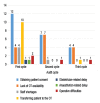Decision-to-Delivery Time Intervals in Emergency Caesarean Section Cases: Repeated cross-sectional study from Oman
- PMID: 28417027
- PMCID: PMC5380420
- DOI: 10.18295/squmj.2016.17.01.008
Decision-to-Delivery Time Intervals in Emergency Caesarean Section Cases: Repeated cross-sectional study from Oman
Abstract
Objectives: In cases of fetal intolerance to labour, meeting the standard decision-to-delivery time interval (DDI) of ≤30 minutes is challenging. This study aimed to assess DDIs in emergency Caesarean section (CS) cases to identify factors causing DDI delays and the impact of a delayed DDI on perinatal outcomes.
Methods: This repeated cross-sectional study included all emergency CS procedures performed due to acute fetal distress, antepartum haemorrhage or umbilical cord prolapse at the Nizwa Hospital, Nizwa, Oman. Three audit cycles of three months each were conducted between April 2011 and June 2013, including an initial retrospective cycle and two prospective cycles following the implementation of improvement strategies to address factors causing DDI delays. Poor perinatal outcomes were defined as Apgar scores of <7 at five minutes, admission to the Special Care Baby Unit (SCBU) or a stillbirth.
Results: In the initial cycle, a DDI of ≤30 minutes was achieved in 23.8% of 84 cases in comparison to 44.6% of 83 cases in the second cycle. In the third cycle, 60.8% of 79 women had a DDI of ≤30 minutes (P <0.001). No significant differences in perinatal outcomes for cases with a DDI of ≤30 minutes versus 31-60 minutes were observed; however, a DDI of >60 minutes was significantly associated with poor neonatal outcomes in terms of increased SCBU admissions and low Apgar scores (P <0.001 each). Factors causing DDI delays included obtaining consent for the CS procedure, a lack of operating theatre availability and moving patients to the operating theatre.
Conclusion: The identification of factors causing DDI delays may provide opportunities to improve perinatal outcomes.
Keywords: Apgar Score; Cesarean Section; Clinical Audit; Fetal Death; Medical Decision-Making; Obstetric Delivery; Oman.
Conflict of interest statement
CONFLICT OF INTEREST The authors declare no conflicts of interest.
Figures
Similar articles
-
The decision delivery interval in emergency caesarean section and its associated maternal and fetal outcomes at a referral hospital in northern Tanzania: a cross-sectional study.BMC Pregnancy Childbirth. 2017 Dec 7;17(1):411. doi: 10.1186/s12884-017-1608-x. BMC Pregnancy Childbirth. 2017. PMID: 29212457 Free PMC article.
-
Determinants of the decision-to-delivery interval and the effect on perinatal outcome after emergency caesarean delivery: a cross-sectional study.Malawi Med J. 2021 Mar;33(1):28-36. doi: 10.4314/mmj.v33i1.5. Malawi Med J. 2021. PMID: 34422231 Free PMC article.
-
Decision-to-delivery intervals and perinatal outcomes following emergency cesarean delivery in a Nigerian tertiary hospital.Int J Gynaecol Obstet. 2015 Sep;130(3):279-83. doi: 10.1016/j.ijgo.2015.03.036. Epub 2015 May 19. Int J Gynaecol Obstet. 2015. PMID: 26058530
-
Decision-Delivery Interval and Perinatal Outcome in Emergency Caesarean Section:A University Teaching Hospital Experience.West Afr J Med. 2014 Oct-Dec;33(4):252-7. West Afr J Med. 2014. PMID: 26445068 English, French.
-
[Decision-to-delivery interval (DDI) for emergency cesarean sections in Polish healthcare system].Ginekol Pol. 2014 Jun;85(6):451-5. doi: 10.17772/gp/1752. Ginekol Pol. 2014. PMID: 25029811 Review. Polish.
Cited by
-
Determinants of early neonatal outcomes after emergency cesarean delivery at Hawassa University comprehensive specialised hospital, Hawassa, Ethiopia.PLoS One. 2022 Mar 24;17(3):e0263837. doi: 10.1371/journal.pone.0263837. eCollection 2022. PLoS One. 2022. PMID: 35324921 Free PMC article.
-
Effect of decision to delivery interval on perinatal outcomes during emergency cesarean deliveries in Ethiopia: A prospective cohort study.PLoS One. 2021 Nov 8;16(11):e0258742. doi: 10.1371/journal.pone.0258742. eCollection 2021. PLoS One. 2021. PMID: 34748563 Free PMC article.
-
Decision to delivery interval for emergency cesarean section and associated factors in africa: systematic review and meta-analysis.BMC Womens Health. 2025 Jul 3;25(1):299. doi: 10.1186/s12905-025-03854-5. BMC Womens Health. 2025. PMID: 40611117 Free PMC article.
-
Umbilical Cord Prolapse-Interesting CTG Traces.Diagnostics (Basel). 2022 Nov 17;12(11):2845. doi: 10.3390/diagnostics12112845. Diagnostics (Basel). 2022. PMID: 36428904 Free PMC article.
-
Decision to Delivery Interval, Perinatal Outcome and Factors Following Emergency Cesarean Section in Southern Ethiopia.Ethiop J Health Sci. 2023 Jan;33(1):39-48. doi: 10.4314/ejhs.v33i1.6. Ethiop J Health Sci. 2023. PMID: 36890945 Free PMC article.
References
-
- Oladapo OT, Sotimehin SA, Ayoola-Sotubo O. Predictors of severe neonatal compromise following Caesarean section for clinically diagnosed foetal distress. West Afr J Med. 2009;28:327–32. - PubMed
-
- Rashid N, Nalliah S. Understanding the decision-delivery interval in Cesarean births. Int EJ Sci Med Educ. 2007;1:61–8.
-
- American Academy of Pediatrics, American College of Obstetricians and Gynecologists. Guidelines for Perinatal Care. 6th ed. Chicago, Illinois, USA: American Academy of Pediatrics; 2007. p. 159.
MeSH terms
LinkOut - more resources
Full Text Sources
Other Literature Sources
Medical
Miscellaneous

